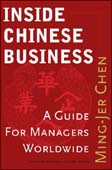Interested in a market that constitutes one-fifth of all the people in the world? Consider China. Many Western companies already have, as the country’s burgeoning economic growth tempts more and more executives to try to navigate the complexities of Chinese business and culture. Ming-Jer Chen, founder/director of Wharton’s
• According to the most recent EIU (Economic Intelligence Unit) report, foreign investment in China amounts to $56.7 billion, a figure surpassed only by foreign investment in the U.S., the U.K. and Germany. The People’s Republic of China attracts more foreign direct investment than any other developing country, with an average annual increase of over 15% a year during the 1990s.
• Last year, Western companies purchased $35.6 billion worth of products from Taiwan alone. Compaq, Dell, Hewlett-Packard and IBM together accounted for $22 billion of that total.
• During 1990-1996, the number of multinational companies in Shanghai increased from 300 to 16,000. More than half of Fortune 500 companies have operations there.
• E-commerce is on the rise in China. According to a report from Andersen Consulting, Chinese will become the number one web language by 2007. Other promising industries include high-tech and high-tech magazines, consumer products and some media sectors.
• China’s entry into the World Trade Organization is now in final negotiations. The move will potentially expand Western business opportunities and help globally integrate China in terms of its reporting system.
Yet Chen says that not all is full steam ahead. He highlights the fact that doing business with the Chinese is, and always has been, a struggle for Western executives, which in turn creates a major barrier for companies hoping to profit from this huge new market. In working extensively with both Chinese and Western managers, Chen has found that “a large and diverse group of professionals feels there’s a profound misunderstanding of Chinese business on the part of the West, stemming mainly from a lack of cultural knowledge.” (The misunderstanding runs so deep, Chen says, that he considered titling his book “The Baffling Chinese.”)
How can non-Chinese managers understand the often puzzling (to them) behavioral characteristics of Chinese businesspeople? Chen believes they need to familiarize themselves at least in part with the social and cultural values of the ethnic Chinese. These values, he asserts, form the basis for Chinese business practices, even pervading day-to-day corporate decisions. “The Chinese company is not just an economic entity. It’s a socio-economic combination. For instance, in the case of overseas Chinese, many businesses are family businesses. Families’ agendas and goals are involved, a situation that often leaves Westerners feeling frustrated and confused about what is going on. Even public companies frequently have their own social networks, which play an important role in the decision-making process. To complicate things even more, in the PRC the majority of companies are still state-owned, or even state-affiliated, so they have a different kind of decision-making and reporting process.”
Chen holds that two of the most essential – and most misunderstood -aspects of Chinese commerce are the family business and the tradition of guanxi, or social networking.
To understand the family business, or rather, the business family (a more appropriate term because family is primary, says Chen,) one must realize that in Chinese culture the family is the basis for all organizations, from social clubs to political parties. It is the driving force behind all activities and decisions in business affairs. Chen identifies four components of the business family:
• Family-directed operation: The business is headed by a patriarch or matriarch and run by the descendants. A complex network of companies is often cross-held to create intra-family dependencies. Organizational charts can be deceptive; an outsider may have trouble identifying where the power really lies.
• Dominant family head: The head of the family makes all the important business decisions. This can be true even in companies that appear “Western,” with high global diversity and formal boards.
• Enduring family obligations: Heirs feel profound responsibility and respect for their family and its business tradition. When assets are passed on, they are usually divided equally among the sons. (It is an indication of just how tradition-steeped Chinese business dealings can be that in spring 2000, the heads of the PRC’s four leading enterprises all announced their intention to pass on their businesses to their sons.)
• Family-financed, family-accountable corporation: Chinese businesses do not rely heavily on external institutions such as banks. This can be an asset since it makes them less vulnerable to political and economic upheaval, and lets them operate seamlessly across borders.
Chen lists other fundamental differences between traditional Chinese and Western firms:
• In the Chinese firm, the purpose is to serve the family’s interests for long-term family prestige. In the Western firm, the purpose is usually to maximize stockholder wealth; focus is on short-run, bottom-line profits and changes in market value of stock.
• The Chinese firm tends to keep financial data private. In the Western firm, audits of financial reports are required.
• The Chinese company is not for sale due to obligations to extended family. The Western company is subject to mergers and acquisitions.
• In the Chinese firm, managers are recruited from within the family. In the Western firm, managers are hired based on merit and attracted by salary.
In addition to the family-run company, the second essential principle to understand is guanxi, key to building successful business relationships with Chinese throughout the world. Guanxi, once described by the Economist as the chief asset of most Chinese companies, refers to a particular kind of social networking grounded in trust, mutual obligations and shared experiences. Chen believes that Western managers dealing with China can, and must, develop their own guanxi networks.
How does guanxi compare with common Western practices such as socializing with clients, taking them out to dinner and/or buying them holiday gifts? Chen characterizes it as all this and more, with some key differences. “In the West we start from business reasons,” says Chen. “We take people out to dinner in order to discuss business. But in the Chinese context, you have to establish a social bond and a relationship before you can start talking about business.
“Another very strong element is reciprocity – an exchange of favors and interactions. I take you out for dinner this time, you take me out next time. And very often it goes beyond just getting to know an individual. A business associate would get to know your family too, perhaps help them in some way, such as hosting them while they’re visiting another city.”
The Chinese “relationship-based mindset” that gives rise to guanxi colors even everyday conversations and interactions. Chen, having spent more than 20 years of his life in Taiwan and 20 in the U.S., and moving frequently between these worlds in his professional life, is deeply aware of this difference between East and West. “I can guarantee that if you meet someone new who is Chinese, within three sentences he or she will start saying, ‘Did you go to Wharton, did you go to Harvard, do you happen to know professor so-and-so, I know this or that professor.’ To Westerners, it sounds like name-dropping. We talk more about our jobs, our interests and so forth. But to the Chinese, it’s a helpful way to place you in the context of your social network and let you understand where they are in theirs.”
Another communication issue with the potential to sour business deals is that ‘yes’ and ‘no’ do not mean in China exactly what they mean here. Chen explains: “‘Yes’ most often means, ‘I hear you and I understand what you’re saying.’” Unfortunately for Western executives, it does not necessarily mean, “I agree to what you want.” Chen adds: “It took me 12 years to learn to use ‘yes’ and ‘no’ in this country in a Western context.”
Chen discusses one other issue that creates serious frustration for many Western executives – corrupt practices in mainland China. A recent Chinese statistic indicates that approximately 16% of China’s GDP is being lost through corruption. This certainly poses a problem for Western firms, but it is also problematic for the Chinese, Chen says. As China prepares to enter the WTO, however, corrupt practices are meeting increasing resistance on at least two fronts: a government that wants to strengthen the country’s economy and improve relations with the West; and a new generation of Chinese entrepreneurs and managers who want to establish the appropriate infrastructure necessary for an advanced economy. “At a minimum, entry into the WTO will bring increased transparency of financial data and more standardized business practices,” he says.
The perception that many Chinese business practices border on corruption raises an additional issue that is perhaps more culturally grounded, Chen adds. “The exchange of presents, for example, that is at the heart of building and maintaining guanxi may qualify as bribery in the West, where corporate gifts must comply with certain regulations (for example, not exceeding $50 in value). As this difference illustrates, the perception of corruption is vitally different from the intention of corruption. Where the exchange of gifts is concerned, drawing the distinction between the two can be a sticky and highly challenging task.”
Some general tips for successful negotiating offered by Chen include:
• Cultivate continuing support from your corporate office, since the Chinese will view you in the context of your network or “family.”
• Use non-business opportunities to enhance intercultural ties.
• Try to see adversity in a positive light. Even a failed negotiation can be a good investment for the future. Think beyond just getting the best possible deal for now; focus instead on building a relationship.
• Don’t show excessive emotion, especially not anger or frustration.
• Be flexible, and as in most business situations, be prepared to compromise.
Chen asserts that an understanding of Chinese values and their impact on modern business conduct can be applied to varying degrees in mainland China, Taiwan, Hong Kong and wherever the roots of traditional Chinese social practices have remained. It can be useful within the U. S., too; Chen points out that 20% of Silicon Valley start-ups are Chinese-owned.
How different are business dealings overall among the PRC, Taiwan and Hong Kong? “That’s my next book,” Chen says with a smile, but adds that in Hong Kong – which in many ways is the epitome of Westernization – a surprising one-third of all agreements are still made orally, harking back to Chinese tradition. And in the PRC, although family influence was subsumed by the state for many decades, the family business is experiencing a resurgence.
Chen hopes that his book helps Westerners understand not only Chinese business dealings, but broader strategies for success in a global economy. “Businesspeople here tend to assume what works in this country works worldwide, that business is business and best practice is best practice, regardless of where they go. And they miss opportunities this way. They need to say to themselves, “We know we have a good product, good technology, a good business practice. If we also pay attention to this region’s cultural, philosophical and organizational differences, we can sell our technologies and products much more effectively. It isn’t that one or the other culture is better or superior.”



